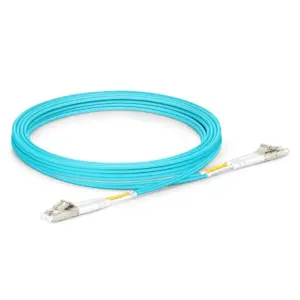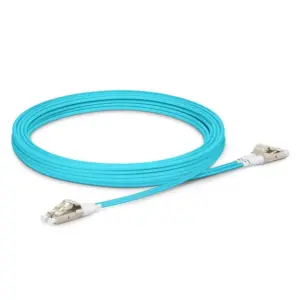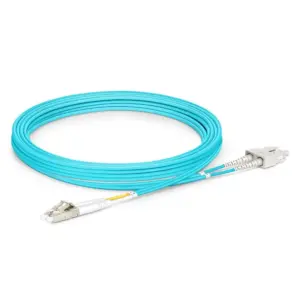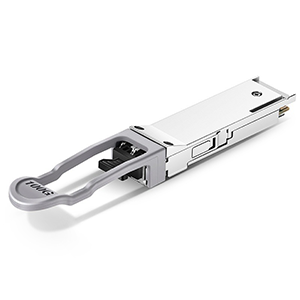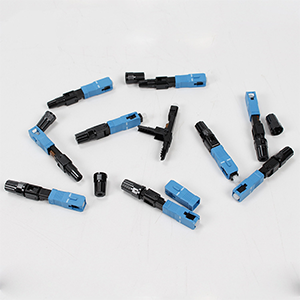I am happy to introduce you to the basic concepts, working principles and applications of OM3 fiber optic cables in different fields. As a multi-mode optical fiber, OM3 optical fiber cable has excellent transmission performance and a wide range of applications, and can meet the needs of high-speed and high-density data transmission.
In this article, I will explain to you the definition and basic principles of OM3 fiber optic cable to help you understand how it transmits optical signals. At the same time, I will also explain the characteristics and uses of OM3 fiber optic cable as a multi-mode optical fiber, as well as its applications in different fields.
Introduction to OM3 fiber optic cable
Definition and rationale:
OM3 fiber optic cable is a fiber optic communication cable that uses OM3 grade optical fiber. It is a multimode fiber (Multimode Fiber, MMF) used to transmit high-speed optical signals. OM3 represents the specifications and performance of optical fiber, with higher bandwidth and transmission capabilities.
The basic principle of OM3 fiber optic cable is to utilize the total internal reflection properties of light to transmit signals. The optical signal propagates through the core of the optical fiber, and total internal reflection occurs at the interface between the core and the cladding to maintain the transmission of the optical signal. Multimode fiber allows multiple light modes to propagate simultaneously along the fiber, making it suitable for short-distance and high-bandwidth applications.
Fiber type:
OM3 optical fiber cable, as a multi-mode optical fiber, has the following characteristics and uses:
-
Bandwidth: OM3 fiber optic cable has high bandwidth, usually 10 Gbps to 40 Gbps, and is suitable for high-speed data transmission and network connections.
-
Distance: OM3 fiber optic cable is suitable for short-distance transmission, usually covering a range of several hundred meters. For long-distance transmission over several hundred meters, single-mode fiber may be required.
-
Application: OM3 optical fiber cables are widely used in environments with high bandwidth requirements such as data centers, enterprise local area networks (LAN), and storage area networks (SAN). It is commonly used to connect servers, switches, storage devices and network devices to achieve fast and reliable data transmission.
-
Connectors: OM3 fiber optic cables usually use multi-mode fiber optic connectors such as MPO/MTP to support multi-channel fiber optic connections. These connectors feature multiple cores to enable high-density fiber optic cabling and connections.
It should be noted that OM3 fiber optic cables may have certain limitations compared to high-performance OM4 and OM5 fiber optic cables in terms of long distances, higher bandwidth requirements, and potential for future upgrades. Therefore, when selecting fiber optic cables, evaluation and selection should be based on specific needs and anticipated network requirements.
Application fields of OM3 optical fiber cable
data center:
OM3 fiber optic cables are widely used in data centers to meet high-speed, high-density data transmission needs. Here are a few major applications for using OM3 fiber optic cables in data centers:
-
Server interconnection: OM3 fiber optic cable can be used to connect servers in the data center to achieve high-speed server interconnection. This is critical for data centers that handle large amounts of data and rapid resource sharing.
-
Data storage connection: Storage devices in the data center, such as disk arrays (SAN), network attached storage (NAS), etc., can be connected through OM3 fiber optic cables to achieve fast data transmission and storage access.
-
Network device connection: OM3 fiber optic cable can be used to connect network switches, routers and other network devices to build high-performance network infrastructure. This helps support fast network connectivity within and between data centers.
local area network:
OM3 optical fiber cables are also widely used in Local Area Network (LAN). Here are some common applications for using OM3 fiber optic cables in local area networks:
-
Office Network: In an office environment, OM3 fiber optic cables can be used to connect computers, printers and other network devices in the office to provide fast and reliable network connections. This helps support business needs such as high-speed data transfer, video conferencing and file sharing.
-
School and campus networks: School and campus networks often need to support data transmission between large numbers of users and devices. OM3 fiber optic cable can meet the high bandwidth needs to connect network equipment between classrooms, laboratories, libraries and other campus buildings.
-
Commercial building network: LANs in commercial buildings usually need to support multiple floors and various services. OM3 fiber optic cable can be used to build high-speed network connections between buildings or within floors to meet the communication needs of enterprises.
In general, the application of OM3 fiber optic cables in data centers and local area networks provides high-speed, high-bandwidth and reliable data transmission solutions. It is suitable for environments that require large-capacity data transmission and supports rapidly developing network and application requirements.
Performance parameters and characteristics of OM3 optical fiber cable
Transmission rate and distance:
OM3 fiber optic cable supports multiple transmission rates and has certain transmission distance characteristics. Here are some common transmission rates and transmission distances for OM3 fiber optic cables:
-
10G Ethernet: OM3 fiber optic cable can support the transmission rate of 10 Gigabit Ethernet (10Gbps) and can usually cover a distance of up to 300 meters. This makes it a commonly used fiber optic solution in data centers and local area networks.
-
40G Ethernet: OM3 fiber optic cable can also be used to support 40 Gigabit Ethernet (40Gbps) transmission rates, which can typically cover distances up to 100 meters. For longer transmission distances, other types of fiber may be required, such as OM4 or single-mode fiber.
It should be noted that the transmission rate and transmission distance may be affected by other factors, such as the compatibility of optical modules and equipment, connector quality, etc. Ensure you get the best performance by using devices and connectors that meet specifications and compatibility requirements.
Bandwidth and loss:
OM3 fiber optic cable has a relatively high bandwidth, which refers to the bandwidth of signals that can be transmitted within a specific frequency range. It usually has a bandwidth of 2000 MHz·km and is suitable for high-speed data transmission and network connections.
However, OM3 fiber optic cable will suffer certain loss during signal transmission, that is, attenuation of the optical signal. This attenuation increases as the transmission distance increases. Therefore, in long-distance transmission, it may be necessary to use signal gain devices or fiber amplifiers to compensate for signal losses.
In addition, OM3 fiber optic cables are also affected by insertion loss, which is the attenuation of optical signals introduced by connecting components such as connectors and distribution boxes. Ensuring the use of good quality connectors and proper installation techniques can reduce insertion loss and increase the reliability of signal transmission.
To sum up, OM3 fiber optic cable has high transmission rate and bandwidth and is suitable for high-speed data transmission and network connection. However, signal loss and insertion loss need to be paid attention to in long-distance transmission to ensure reliable transmission of optical signals.
Installation and wiring of OM3 fiber optic cable
Optical cable installation:
The following is the installation guide for OM3 fiber optic cable, including steps for connecting and fixing the fiber optic cable:
-
Preparation: Before starting the installation, ensure that the necessary planning and layout design have been carried out. Determine the path and connection points for the fiber optic cable and prepare the required tools and materials.
-
Fiber optic cable connection: Match the connection end of the OM3 fiber optic cable with the corresponding connector, and use the fiber optic connector to connect. This may involve using a fiber stripping tool to strip the insulation from the outer layer of the fiber optic cable, followed by appropriate core preparation and connection depending on the connector type.
-
Connection protection: To ensure the stability and reliability of the connection, you can use fiber optic connection boxes, heat shrink tubes or other connection protection devices to protect the connection points. This helps prevent the fiber from being bent, stretched, or damaged and maintains the stability of the connection.
-
Fiber optic cable fixation: Use suitable fixing devices to secure the fiber optic cable in the desired location. This can be accomplished using equipment such as cable clamps, clips, hangers, etc. Make sure that the optical cable is firmly fixed and not interfered with by external forces.
Fiber optic cable routing:
When wiring OM3 fiber optic cables, the following methods and precautions need to be considered to ensure good signal transmission and performance:
-
Path planning: Before wiring, carefully plan the path of the optical cable to avoid being close to power lines, electromagnetic interference sources, and other equipment that may cause interference. Choose the best routing path to minimize bends and pulls.
-
Bending radius: OM3 fiber optic cable has certain bending radius requirements and should not exceed its specified minimum bending radius. Make sure you do not bend the fiber optic cable excessively during the wiring process to prevent optical signal loss and performance degradation.
-
Protection measures: Use appropriate protection measures, such as fiber optic ducts, conduits, or sheaths, to protect fiber optic cables from physical damage when they need to pass through floors, walls, or other obstacles.
-
Identification and management: Proper identification and management of cabling, including marking the origin, termination and relay points of fiber optic cables. This helps simplify maintenance and troubleshooting processes and improves overall management efficiency.
-
Installation techniques: During the installation process, pay attention to using the correct tools and techniques. Follow the manufacturer’s guidelines and best practices to ensure correct and reliable fiber optic cable connection and routing procedures.
Important note: Fiber optic cable installation and wiring usually require professional technicians to ensure correctness and safety. If you do not have the necessary technical knowledge and experience, it is recommended to seek the help of a qualified fiber optic cable installation professional.
OM3 fiber optic cable compatibility and interface
Compatibility points:
OM3 fiber optic cable has certain compatibility points in terms of fiber optic cable connector type and fiber optic interface. Here are some key takeaways:
-
Connector type: Commonly used connector types for OM3 fiber optic cable include LC (common in data centers and LANs), SC and MPO/MTP, etc. Compatibility points involve the correct selection and matching of connector types to ensure compatibility and reliability between connectors.
-
Fiber optic cable connectors: OM3 fiber optic cables usually use pre-assembled fiber optic connectors, which are already connected to the fiber optic cable during the manufacturing process. Be sure to select the connector type and jack type that match the fiber optic cable connector to ensure proper connection and transmission performance.
-
Fiber optic interface: The fiber optic interface of the OM3 fiber optic cable should match the interface standard of the connected device. Common optical fiber interface standards include ST, SC, LC, etc. When connecting devices, make sure to use fiber optic connectors and fiber interfaces that match the device interface standards.
Interface standards:
Common interface standards for OM3 fiber optic cables include the following:
-
LC (Lucent Connector) interface: The LC interface is a miniaturized optical fiber connector that is commonly used in high-density optical fiber cabling environments, such as data centers and enterprise networks. It has low insertion loss and high reliability.
-
SC (Subscriber Connector) interface: SC interface is a common optical fiber connector, widely used in LAN and WAN and other fields. It features simple connection and removal features and is suitable for both single-mode and multi-mode fiber.
-
MPO/MTP (Multi-Fiber Push-On/Pull-Off) interface: The MPO/MTP interface is a multi-core optical fiber connector used to achieve high-density optical fiber cabling. It supports simultaneous connections of multiple optical fibers and is suitable for high-speed data transmission and data center applications.
These interface standards are defined based on the physical shape and size of fiber optic connectors to ensure compatibility and interchangeability. When selecting and using OM3 fiber optic cables, be sure to match the required interface standards for proper connection and good signal transmission performance.
Advantages and future development of OM3 optical fiber cable
High speed transmission:
OM3 fiber optic cable provides the advantages of high-speed data transmission and adapts to the growing network needs. Here are the key advantages of its high-speed transmission:
-
High bandwidth: OM3 optical fiber cable supports high-bandwidth transmission and can meet the needs of large-capacity data transmission. Its transmission rate can reach 10 Gbps (gigabits per second), making it suitable for high-speed network and data center applications.
-
Long-distance transmission: OM3 optical fiber cable has a large transmission distance capability. For multi-mode optical fiber, it can provide high-speed data transmission within a distance of 550 meters, suitable for cross-floor or cross-campus network cabling.
-
Anti-interference ability: OM3 optical fiber cable has good anti-interference performance and can maintain stable transmission quality in an electromagnetic interference environment. This makes it particularly suitable for industrial environments or places with high electromagnetic radiation.
Future trends:
OM3 fiber optic cable has continuous development trends in technology and applications to meet the growing network needs. Here are some future trends:
-
Higher transmission rates: As network demands grow, OM3 fiber optic cables will continue to evolve to support higher transmission rates. For example, new generation optical fiber standards such as OM4, OM5 and OM6 can provide higher transmission rates, such as 40 Gbps, 100 Gbps or even higher.
-
Lower loss: Future OM3 fiber optic cables will continue to be improved to reduce the loss of optical signals. This includes reducing fiber attenuation loss, reducing insertion loss and refractive loss, etc., to improve transmission efficiency and performance.
-
High-density cabling: As data centers and communication networks continue to expand, the demand for high-density cabling is also increasing. Future OM3 fiber optic cables will evolve in connector design and cabling technology to support higher port density and more compact network architectures.
-
Compatibility and interoperability: Future development trends will focus on the compatibility and interoperability of fiber optic cables. This means that different types of fiber optic cables and fiber optic interfaces will be more compatible to achieve flexible connections and interoperability in different network environments.
Overall, OM3 fiber optic cable, as a solution for high-speed data transmission, plays an important role in the ever-evolving network field. Its advantages and future development trends will further promote the high speed, high density and reliability of the network.
Summarize:
By reading this article, you will have a deeper understanding of the basic concepts, working principles and applications of OM3 optical fiber cables in different fields. As a multi-mode optical fiber, OM3 optical fiber cable can meet the needs of high-speed and high-density data transmission and provide reliable data transmission and communication.
We look forward to exploring the advantages and future development of OM3 fiber optic cables with you and providing reliable solutions for your data transmission needs. If you have any further questions or needs about OM3 fiber optic cable, please feel free to contact us. I wish you better experiences and results in the world of high-speed data transmission!


